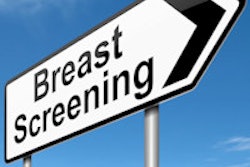
The number and cost of breast ultrasound exams more than doubled in New Jersey after the state enacted a breast density notification law in 2014, according to a new study published in the October issue of the Journal of the American College of Radiology.
The findings indicate that density notification laws can carry a heavy financial cost, to say nothing of possible clinical limitations of the technology, such as high false-positive rates and low positive predictive value, according to lead author John Sobotka of St. George's University School of Medicine in St. George's, Grenada, and colleague Dr. Clay Hinrichs of Hackettstown Regional Medical Center in Hackettstown, NJ.
 John Sobotka of St. George's University.
John Sobotka of St. George's University."By guaranteeing coverage for breast sonography, the legislation intends to reduce the number of patients who may decline [the exams] in order to avoid out-of-pocket expenses," the two wrote. "As expected, and confirmed in our data, this has led to a significant increase in the numbers of those undergoing screening ultrasound examinations, resulting in an increased overall reimbursement amount."
The Garden State
Sobotka and Hinrichs conducted the study to assess the financial effects of New Jersey's breast density notification bill, focusing first on Hackettstown Regional Medical Center. The bill was signed into law in January 2014 and enacted in May of that year (JACR, October 2015, Vol. 12:10, pp. 1011-1015).
"We saw that we had an opportunity to study this issue because the law had passed and we knew the date it would be enacted, so we could compare ultrasound volume before and after," Hinrichs told AuntMinnie.com.
The study included a sample of patients seen for mammography and subsequent breast ultrasound at the medical center three months before and three months after the law was enacted. The researchers then evaluated the cost of the legislation using a reimbursement rate of $225.83 per exam, based on Medicare's breast ultrasound global reimbursement rates for New Jersey. This calculation didn't include costs associated with preparing the department for compliance with the law, which included revamping its ultrasound department, purchasing an additional ultrasound unit, and appointing a dedicated technologist to perform breast ultrasound throughout the day, Sobotka and Hinrichs noted.
After New Jersey's breast notification law went into effect, the percentage of women who had follow-up ultrasounds after mammography more than doubled, the researchers found.
| No. of follow-up ultrasound scans after breast density law | |||||
| Pre-enactment of law (January to March, 2014) | Postenactment of law (May to July, 2014) | ||||
| Average No. of women who had mammography | 415 | 452 | |||
| Average No. of women who had supplemental US | 73 | 190 | |||
| Percent follow-up | 17.6% | 42.2% | |||
Sobotka and Hinrichs then extrapolated from these results to estimate changes in ultrasound exam volume and reimbursement payments across the state after the law was enacted.
Depending on the percentage of women with dense breast tissue who would have an ultrasound exam after mammography, the May to July data suggested an additional 21,746 to 43,612 breast ultrasounds each month and additional reimbursement payments in the range of $4.9 million to $9.8 million each month.
The researchers further estimated that the total cost of following up breast ultrasound across the state ranged from $4 million to $6 million before the law went into effect to $11 million to $14 million afterward.
The bottom line?
Ultrasound may find more cancers in women with dense breast tissue, but this benefit must be weighed against the risk of unnecessary studies, false positives, and increased healthcare costs, Sobotka and Hinrichs concluded.
"Although further screening may lead to better diagnostics, it also opens the door to false positives and additional, unnecessary testing," they wrote. "As other states begin to contemplate similar legislation, it is important to understand the financial repercussions."




















